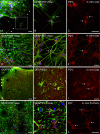Pathophysiology of astroglial purinergic signalling
- PMID: 22544529
- PMCID: PMC3360100
- DOI: 10.1007/s11302-012-9300-0
Pathophysiology of astroglial purinergic signalling
Abstract
Astrocytes are fundamental for central nervous system (CNS) physiology and are the fulcrum of neurological diseases. Astroglial cells control development of the nervous system, regulate synaptogenesis, maturation, maintenance and plasticity of synapses and are central for nervous system homeostasis. Astroglial reactions determine progression and outcome of many neuropathologies and are critical for regeneration and remodelling of neural circuits following trauma, stroke, ischaemia or neurodegenerative disorders. They secrete multiple neurotransmitters and neurohormones to communicate with neurones, microglia and the vascular walls of capillaries. Signalling through release of ATP is the most widespread mean of communication between astrocytes and other types of neural cells. ATP serves as a fast excitatory neurotransmitter and has pronounced long-term (trophic) roles in cell proliferation, growth, and development. During pathology, ATP is released from damaged cells and acts both as a cytotoxic factor and a proinflammatory mediator, being a universal "danger" signal. In this review, we summarise contemporary knowledge on the role of purinergic receptors (P2Rs) in a variety of diseases in relation to changes of astrocytic functions and nucleotide signalling. We have focussed on the role of the ionotropic P2X and metabotropic P2YRs working alone or in concert to modify the release of neurotransmitters, to activate signalling cascades and to change the expression levels of ion channels and protein kinases. All these effects are of great importance for the initiation, progression and maintenance of astrogliosis-the conserved and ubiquitous glial defensive reaction to CNS pathologies. We highlighted specific aspects of reactive astrogliosis, especially with respect to the involvement of the P2X(7) and P2Y(1)R subtypes. Reactive astrogliosis exerts both beneficial and detrimental effects in a context-specific manner determined by distinct molecular signalling cascades. Understanding the role of purinergic signalling in astrocytes is critical to identifying new therapeutic principles to treat acute and chronic neurological diseases.
Figures





References
-
- Kettenmann H, Ransom BR (2005) Neuroglia. Oxford University Press, Oxford, p. 601
-
- Verkhratsky A, Butt A. Glial neurobiology. A textbook. Chichester: Wiley; 2007. p. 220.
-
- Franke H, Illes P. Involvement of P2 receptors in the growth and survival of neurons in the CNS. Pharmacol Ther. 2006;109:297–324. - PubMed
-
- Burnstock G. Physiology and pathophysiology of purinergic neurotransmission. Physiol Rev. 2007;87:659–797. - PubMed
Publication types
MeSH terms
Substances
LinkOut - more resources
Full Text Sources

